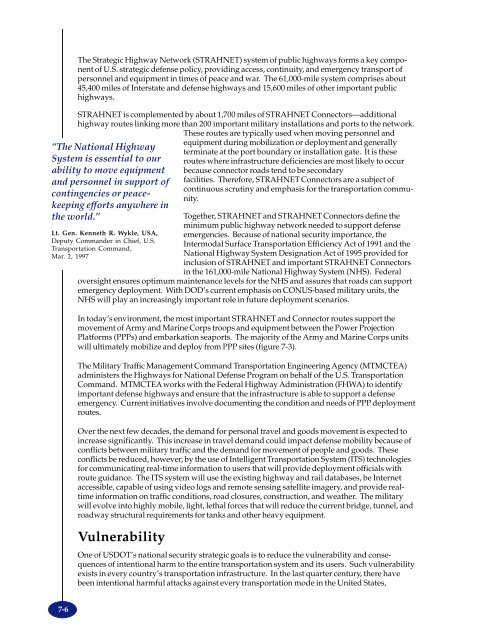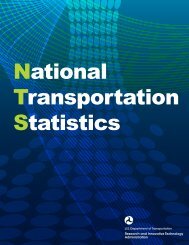TRANSPORTATION - BTS - Bureau of Transportation Statistics
TRANSPORTATION - BTS - Bureau of Transportation Statistics
TRANSPORTATION - BTS - Bureau of Transportation Statistics
Create successful ePaper yourself
Turn your PDF publications into a flip-book with our unique Google optimized e-Paper software.
The Strategic Highway Network (STRAHNET) system <strong>of</strong> public highways forms a key component<strong>of</strong> U.S. strategic defense policy, providing access, continuity, and emergency transport <strong>of</strong>personnel and equipment in times <strong>of</strong> peace and war. The 61,000-mile system comprises about45,400 miles <strong>of</strong> Interstate and defense highways and 15,600 miles <strong>of</strong> other important publichighways.STRAHNET is complemented by about 1,700 miles <strong>of</strong> STRAHNET Connectors—additionalhighway routes linking more than 200 important military installations and ports to the network.These routes are typically used when moving personnel and“The National HighwaySystem is essential to ourability to move equipmentand personnel in support <strong>of</strong>contingencies or peacekeepingefforts anywhere inthe world.”equipment during mobilization or deployment and generallyterminate at the port boundary or installation gate. It is theseroutes where infrastructure deficiencies are most likely to occurbecause connector roads tend to be secondaryfacilities. Therefore, STRAHNET Connectors are a subject <strong>of</strong>continuous scrutiny and emphasis for the transportation community.Together, STRAHNET and STRAHNET Connectors define theminimum public highway network needed to support defenseemergencies. Because <strong>of</strong> national security importance, theIntermodal Surface <strong>Transportation</strong> Efficiency Act <strong>of</strong> 1991 and theNational Highway System Designation Act <strong>of</strong> 1995 provided forinclusion <strong>of</strong> STRAHNET and important STRAHNET Connectorsin the 161,000-mile National Highway System (NHS). Federaloversight ensures optimum maintenance levels for the NHS and assures that roads can supportemergency deployment. With DOD’s current emphasis on CONUS-based military units, theNHS will play an increasingly important role in future deployment scenarios.Lt. Gen. Kenneth R. Wykle, USA,Deputy Commander in Chief, U.S.<strong>Transportation</strong> Command,Mar. 2, 1997In today’s environment, the most important STRAHNET and Connector routes support themovement <strong>of</strong> Army and Marine Corps troops and equipment between the Power ProjectionPlatforms (PPPs) and embarkation seaports. The majority <strong>of</strong> the Army and Marine Corps unitswill ultimately mobilize and deploy from PPP sites (figure 7-3).The Military Traffic Management Command <strong>Transportation</strong> Engineering Agency (MTMCTEA)administers the Highways for National Defense Program on behalf <strong>of</strong> the U.S. <strong>Transportation</strong>Command. MTMCTEA works with the Federal Highway Administration (FHWA) to identifyimportant defense highways and ensure that the infrastructure is able to support a defenseemergency. Current initiatives involve documenting the condition and needs <strong>of</strong> PPP deploymentroutes.Over the next few decades, the demand for personal travel and goods movement is expected toincrease significantly. This increase in travel demand could impact defense mobility because <strong>of</strong>conflicts between military traffic and the demand for movement <strong>of</strong> people and goods. Theseconflicts be reduced, however, by the use <strong>of</strong> Intelligent <strong>Transportation</strong> System (ITS) technologiesfor communicating real-time information to users that will provide deployment <strong>of</strong>ficials withroute guidance. The ITS system will use the existing highway and rail databases, be Internetaccessible, capable <strong>of</strong> using video logs and remote sensing satellite imagery, and provide realtimeinformation on traffic conditions, road closures, construction, and weather. The militarywill evolve into highly mobile, light, lethal forces that will reduce the current bridge, tunnel, androadway structural requirements for tanks and other heavy equipment.VulnerabilityOne <strong>of</strong> USDOT’s national security strategic goals is to reduce the vulnerability and consequences<strong>of</strong> intentional harm to the entire transportation system and its users. Such vulnerabilityexists in every country’s transportation infrastructure. In the last quarter century, there havebeen intentional harmful attacks against every transportation mode in the United States,7-6
















